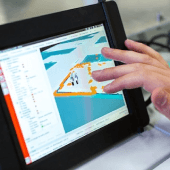Table of Content
- Spherical Tanks Internal Inspection
- Preparation of Internal Inspection Requirements
- Conventional NDT used for Internal Inspection
The LPG spherical tank is a fixed-pressure vessel at normal temperature, with a single-layer tank structure, dedicated to storing liquefied petroleum gas, using steel plates for the vessel, with excellent performance, safety, and reliability. The spherical tank is quite important to the storage and production process. It can be eroded by the internal medium and may defects such as corrosion, cracks, and holes in the walls and welds.
For these reasons, inspection of LPG tanks is very important. Also, Inspection is a necessary means to ensure the safe operation of the spherical tank.
Inspection is mainly conducted to identify wear and tear, and corrosion around components such as vessel connections, welded nozzles and seams, and areas near to welds, external controls, fittings, and so on.
Spherical Tanks Internal Inspection
Unless justified by an RBI assessment, the period between internal or on-stream inspections shall not exceed one-half the remaining life of the LPG vessel or 10 years, whichever is less.
LPG Tanks are designed to store LPG gas. Leaks or failures in tanks may lead to major accidents on site. Inspection is done to identify these failures and leaks in the LPG tank. Inspection involves measurements and testing. The inspection is done on a non-destructive basis. To improve quality control inspection is most important. Inspection also ensures the safety or reliability of structures. During inspection, it is necessary to do the inspection using proper steps.
Also Read, Fire Safety in LPG Tanks and Anatomy of BLEVE
Preparation of Internal Inspection Requirements
Internal inspections require the tank to be empty so that the internals of the tank can be checked to ensure that there is no corrosion, wastage, or damage due to the contents of the tanks. The thickness of the internal walls is also measured to test structural integrity.
To inspect the tank internally, the tank should be decommissioned, and an atmosphere should be created in which an inspection expert can work safely.
These processes are generally called Gas-free, but it is not enough for safety.
In addition, there must be sufficient oxygen and no toxic vapours or substances inside.
Furthermore, there should be sufficient lighting inside the tank so that the inspection expert can visually inspect the welds with the naked eye.
Conventional NDT used for internal Inspection
The most common methods are Visual Testing, Magnetic Particle Testing, Penetrant Testing, Ultrasonic Testing, Radiographic Testing and Eddy Current. In these tests, defects such as corrosion, cracks, decrease in wall thickness or gaps in internal structures are identified in ferritic and austenitic steels, aluminium alloys, nickel, copper and titanium alloys during production or usage. Non-destructive testing methods can change depending on the procedure, size, thickness, and structure of the material.
Visual Inspection.
VT is the fastest and cheapest method of Non-destructive testing. It’s the first step of every inspection before any other Non-destructive test starts. When performing visual tests with the naked eye, equipment such as a magnifying glass, light source, borescope, and mirror can also be used.
The condition of the surface is important to detect discontinuities such as cracks, porosities, and undercuts. Required cleanings must be finished before visual testing starts. surface cleaning is very important.
Visual Testing is perhaps the oldest and most widely used inspection technique. Often the eyes of the inspector are the only “equipment” used for the inspection. Visual İnspection is applicable to virtually any material, at any stage of manufacture, at any point in its service life. To perform a successful direct visual examination, adequate lighting and good inspector eyesight are required.
VT seems like an easy method, but it has its own inspection terms, and the experience of the staff is important. The test should be performed under enough light, a minimum of 500 lux, with an angle not lower than 30° and the distance between the eye and the surface shouldn’t be less than 300 mm.
Ultrasonic Testing
Wall Thickness & Metal Loses measurements using UT Thickness Gauges include A- scan feature to able to detect corrosion failure and display reading in Digital & A- scan view.
Magnetic Testing
MT is essentially a surface-type examination, although some imperfections just below the surface are detectable. This type of examination i s limited to materials that can be magnetized ( hence it is not appropriate for austenitic stainless steels). An area to be examined by magnetic particle examination can be completely examined or examined on a random sampling basis, as specified.
Penetrant Testing
PT is a method to detect surface-connected defects. It is important to have a clean and smooth surface. After mechanical, and chemical precleaning the surface must be dry and any dirt such as rust, oil, or paint should be cleaned from the surface as it will affect the process. The biggest advantage of this method is it has no restrictions about the material.
Radiography Testing
Random RT X-ray or gamma-ray radiography may be used. The selection of the method should be dependent upon its adaptability to the work being radiographed. When random radiography of welds is specified by the engineering design, it should be done on the number of welds designated. The engineering design shall specify the extent to which each examined weld should be radiographed. Random radiography may also be used for the examination of piping components such as a valve or fitting to any extent specified by the engineering design.













